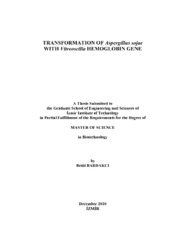Please use this identifier to cite or link to this item:
https://hdl.handle.net/11147/3456Full metadata record
| DC Field | Value | Language |
|---|---|---|
| dc.contributor.advisor | Tari, Canan | en |
| dc.contributor.author | Bardakçı, Betül | - |
| dc.date.accessioned | 2014-07-22T13:51:34Z | - |
| dc.date.available | 2014-07-22T13:51:34Z | - |
| dc.date.issued | 2010 | en |
| dc.identifier.uri | http://hdl.handle.net/11147/3456 | - |
| dc.description | Thesis (Master)--Izmir Institute of Technology, Biotechnology, Izmir, 2010 | en |
| dc.description | Includes bibliographical references (leaves: 65-75) | en |
| dc.description | Text in English; Abstract: Turkish and English | en |
| dc.description | xi, 87 leaves | en |
| dc.description.abstract | Aspergillus sojae known as koji mold is a non-aflatoxigenic fungus, designated with a GRAS status by FDA. This study considers the transformation of A. sojae with Vitreoscilla hemoglobin gene. Vitreoscilla hemoglobin is the bacterial hemoglobin, which enhances the oxygen transfer under microaerophilic conditions. Since industrial fungal fermentation with the high demand for oxygen are accounted to face oxygen limitations during the production of value added products like enzymes, antibiotics and organic acids; oxygen supply becomes an enormous problem to be solved by the manufacturers. To overcome this problem, an alternative solution using the vgb gene of Vitreoscilla and recombinant DNA technology and taking the A. sojae organism as model organism was proposed. The product of interest in this study was the exopolygalacturonase enzyme known to have wide applications in food, pharmaceutical, textile and paper industries. Here vgb gene was tried to be introduced to A .sojae via both protoplasting and electroporation methods. For transformation process vgb gene was cloned initially into plasmid ANIp4. For the selection of transformed A. sojae cells, uridine auxotrophic mutants were tried to be selected after UV mutagenesis. However, using a procedure based on selection of uridine supported growth did not result in A. sojae pyrG mutants. The success of transformation was initially observed by means of PCR analysis and agarose gel electrophoresis, later this was try to be confirmed by sequence analysis and agarose gel electrophoresis. However, due to the contamination problems accounted in the procedures the transformation with both methods could not be assured. | en |
| dc.language.iso | en | en_US |
| dc.publisher | Izmir Institute of Technology | en |
| dc.rights | info:eu-repo/semantics/openAccess | en_US |
| dc.subject.lcsh | Aspergillus--Genetics | en |
| dc.subject.lcsh | Aspergillus--Biotechnology | en |
| dc.title | Transformation of aspergillus sojae with vitreoscilla hemoglobin gene | en_US |
| dc.type | Master Thesis | en_US |
| dc.institutionauthor | Bardakçı, Betül | - |
| dc.department | Thesis (Master)--İzmir Institute of Technology, Bioengineering | en_US |
| dc.relation.publicationcategory | Tez | en_US |
| item.fulltext | With Fulltext | - |
| item.grantfulltext | open | - |
| item.openairetype | Master Thesis | - |
| item.openairecristype | http://purl.org/coar/resource_type/c_18cf | - |
| item.languageiso639-1 | en | - |
| item.cerifentitytype | Publications | - |
| Appears in Collections: | Master Degree / Yüksek Lisans Tezleri | |
Files in This Item:
| File | Description | Size | Format | |
|---|---|---|---|---|
| T000862.pdf | MasterThesis | 1.96 MB | Adobe PDF |  View/Open |
CORE Recommender
Page view(s)
72
checked on Apr 29, 2024
Download(s)
58
checked on Apr 29, 2024
Google ScholarTM
Check
Items in GCRIS Repository are protected by copyright, with all rights reserved, unless otherwise indicated.